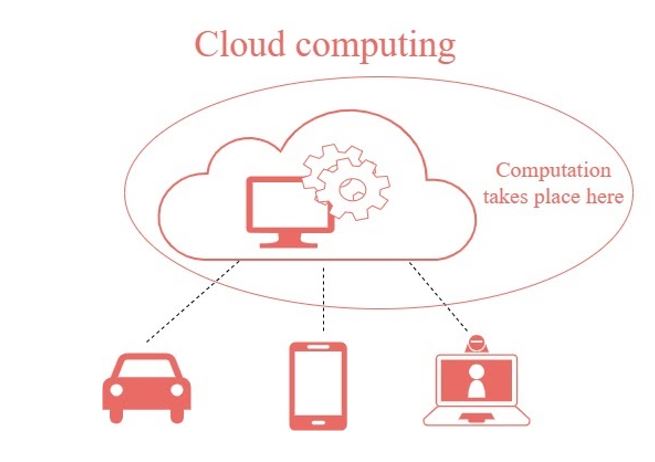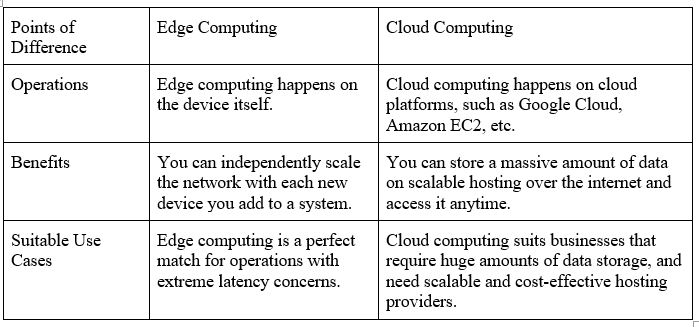
Click here to learn more about Vladimir Belyi.
Edge computing and cloud computing solve different network infrastructure issues.
While edge computing works in the Internet of things (IoT) industry, cloud computing includes software development platforms, storage, and servers provided via internet connectivity. Therefore, the use of edge computing does not preclude the use of cloud computing and vice versa. To find out which solution to choose for your network infrastructure, you should be aware of both approaches and their uses.
What is Edge Computing?
Edge computing is a decentralized computing infrastructure approach where algorithmic decisions and computer processing occur at the edge of a computer network. In this way, edge computing provides immediate data analysis.

Examples of Edge Computing
Businesses use edge computing to receive immediate and individualized results. Thus, we can see the application of edge computing in the following use cases:
- Autonomous Vehicles
Autonomous cars leverage from 400 to 500 sensors that process 40 terabytes of data every eight hours. To empower them with useful data analysis, manufacturers use edge computing. It allocates the workload inside the car instead of relying on removed data centers.
For instance, Renovo, an open-source autonomous vehicle platform, is partnering with EdgeConneX, an edge computing provider, to push as many processes as possible of a self-driving car into the vehicle itself.
- Streaming Services
Many video streaming services, such as Netflix, create a heavy load on network infrastructure that impacts video quality. To avoid this, companies apply the power of edge computing for data caching. Edge computing caches popular content in facilities located closer to the end-user. Video streaming companies provide end users with quicker access to video streams. At the same time, businesses reduce transit costs and deliver a higher-quality, low-latency stream.
- Smart Homes
Smart-home manufacturers are also facing network load issues. So, they can no longer rely on cloud computing alone. Edge computing allows smart-home businesses to process information closer to the source. In this way, companies achieve quicker response times and less latency in emergency scenarios. An example is SWIM.AI, an edge computing provider that leverages the power of edge computing for IoT and smart city solutions in the SWIM EDX platform. It runs on existing edge devices, forms a powerful edge compute ‘mesh,’ and enables local data ingestion.
- Voice Assistance
Personal assistants like Siri take a lot of time to communicate with cloud servers when accomplishing user requests. For this reason, they are less helpful when you’re outside the reach of Wi-Fi or cellular services. Edge computing allows smart assistants to perform users’ requests without connecting to the internet.
Edge computing is one promising networking architecture to increase the effectiveness of voice-activated devices. Edge computing places high-performance compute, storage, and network resources as close as possible to end users and devices. In this way, edge computing reduces the burden of data transport, decreases latency, and increases locality.
What is Cloud Computing?
Cloud computing is a centralized network of remote servers. It provides on-demand availability of computing and storage resources over an internet connection.

Examples of Cloud Computing
Cloud computing is for businesses that need a scalable solution to store and analyze vast amounts of data. The most successful examples of cloud computing are the following:
- General Electric
Due to its scalability, cloud computing is for companies that no longer want to run their data centers on physical servers. The first industry leader who leveraged cloud hosting was General Electric (GE). Since 2014, the company has used the cloud to host more than 2,000 cloud-based apps and services.
Pinterest, a social media network, aggregates large amounts of data. The company uses cloud services to adjust its system to varying traffic levels. It maintains a small team.
- Etsy
Scalability is not the only reason for businesses to move their infrastructure to the cloud. People also prefer cloud due to its cost-effectiveness. Etsy, an eCommerce marketplace, has been analyzing a terabyte of data daily since 2011. To use big data for predictive analytics, the company chose a cloud computing solution. Now Etsy provides more relevant product recommendations in the web site’s Taste Test section.
Comparisons Between Edge Computing and Cloud Computing
The table below summarizes the differences between edge and cloud computing.

In a nutshell, both edge and cloud computing are different technologies, neither of which can replace the other. Edge computing helps you to process time-sensitive data, while cloud computing is aimed at processing data that is not time-driven. Also, edge computing is a perfect solution for intelligent devices with remote locations where there is no connectivity to a centralized location.
Cloud or Edge: What is the Most Effective Solution?
Edge computing and cloud computing are aimed at solving different problems. Edge computing works the best for IoT devices, sensors, and self-driven cars that need to analyze, collect, and transform data with extreme latency. Cloud computing helps organizations to store and analyze vast amounts of data on scalable hosting, run websites and application’s infrastructure, and leverage other services to save costs.
